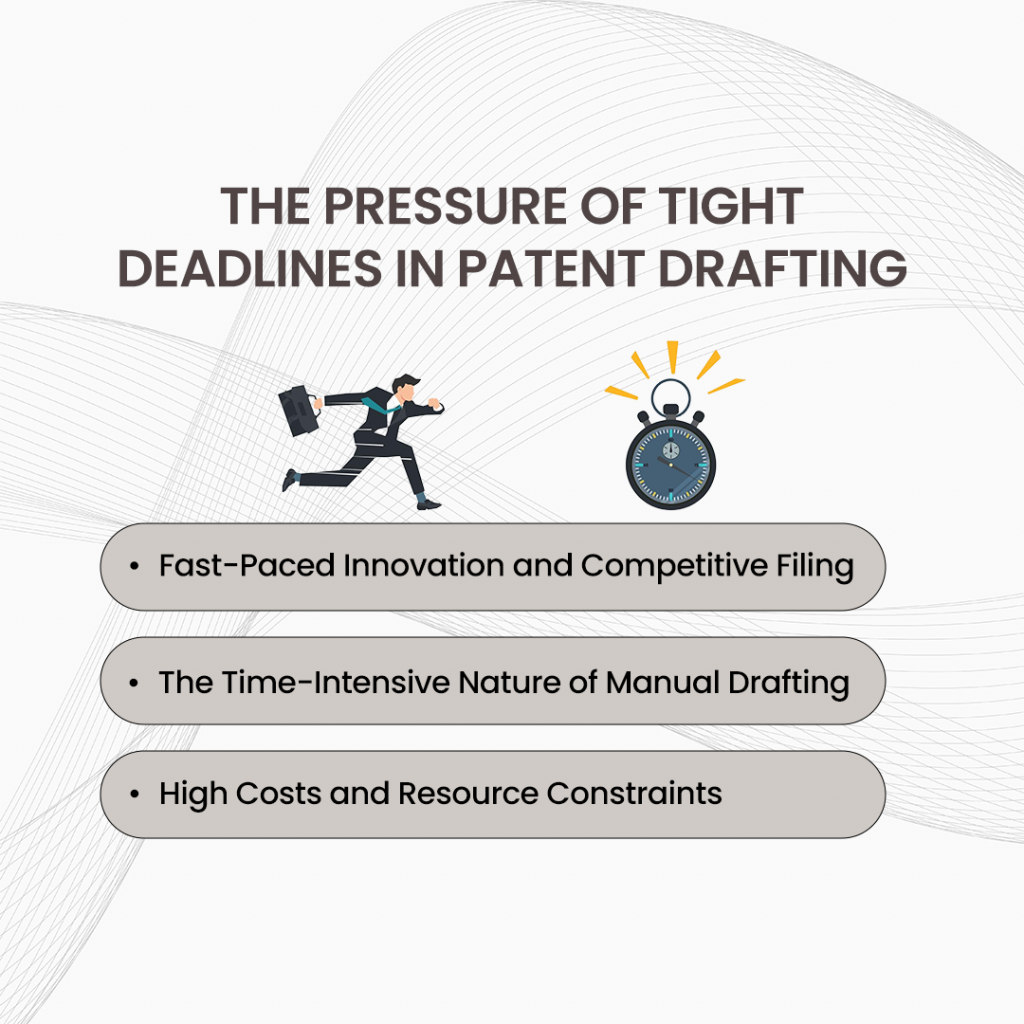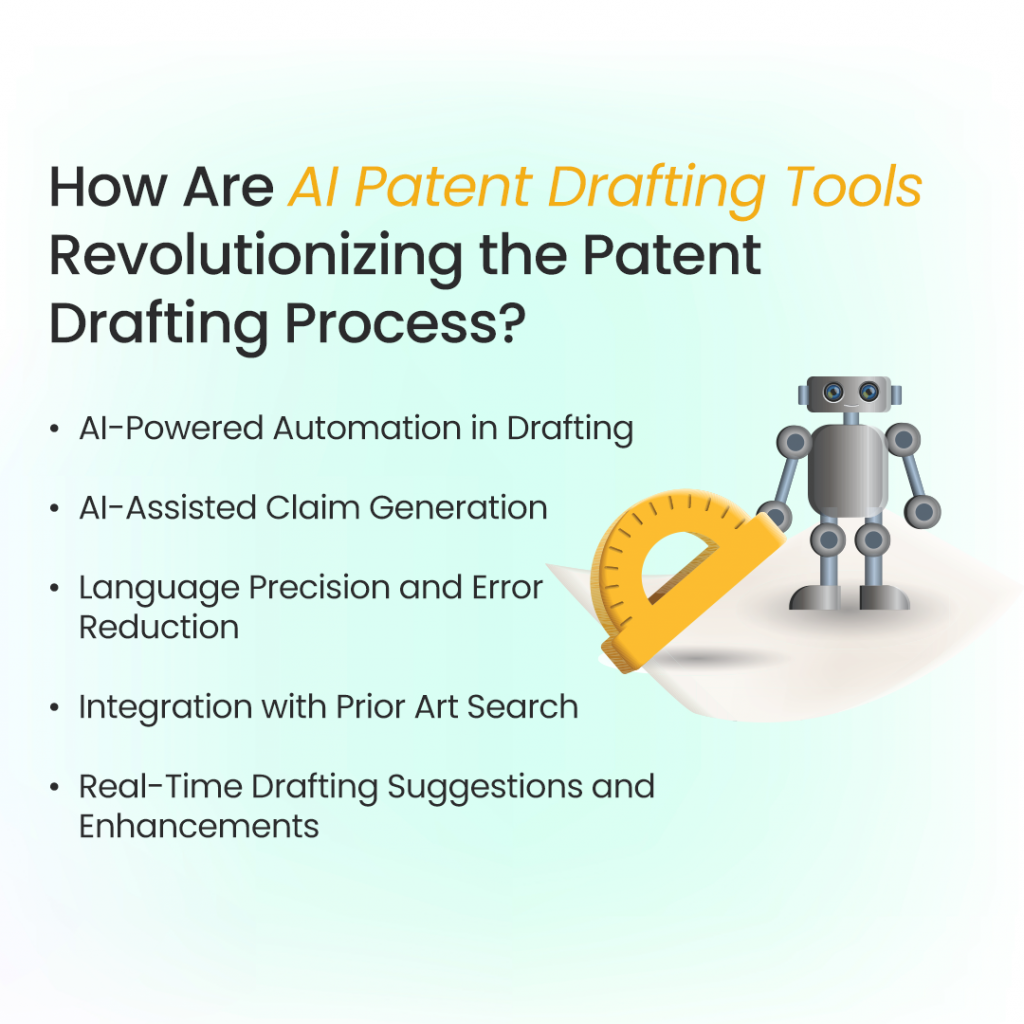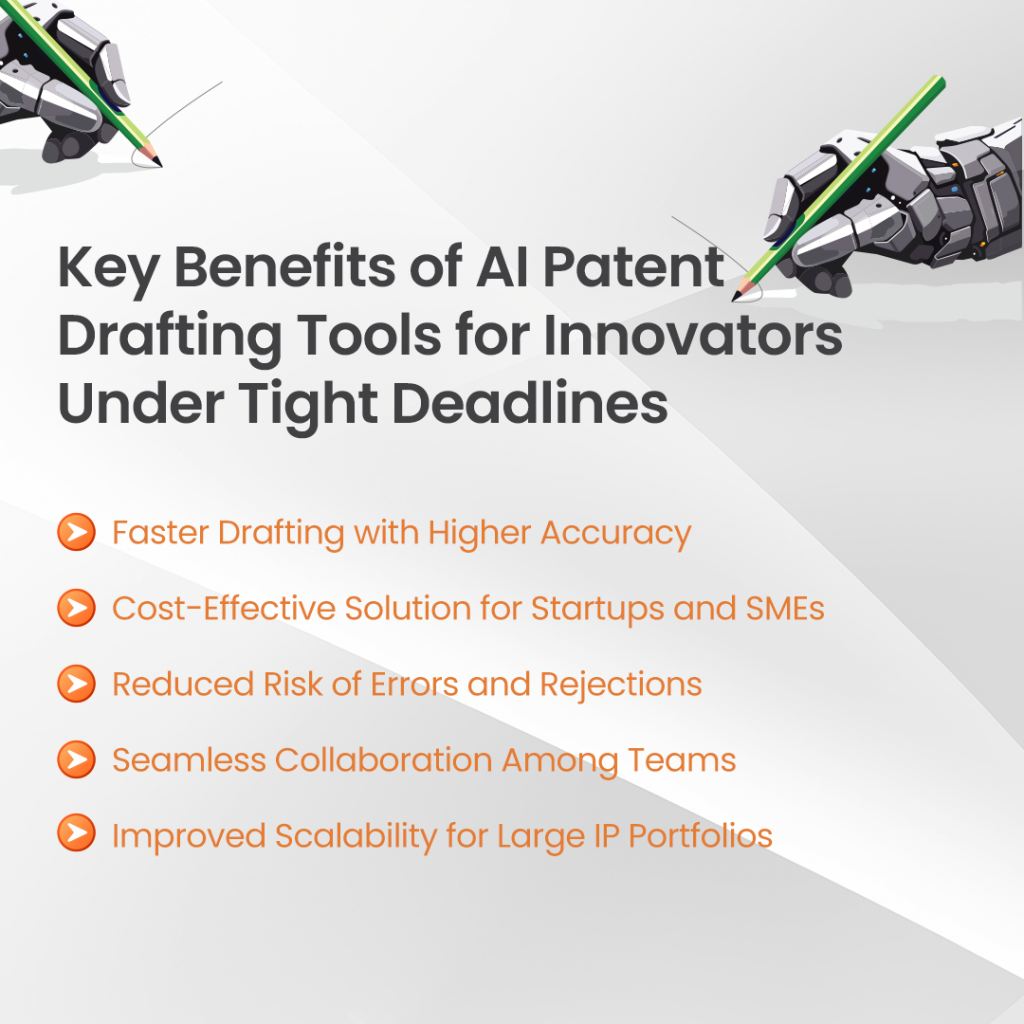
Introduction
Patent drafting is a high-stakes process that demands precision, completeness, and speed. A well-drafted patent application can determine the strength of an inventor’s intellectual property rights, securing protection against competitors and ensuring enforceability in legal disputes.
However, even minor drafting errors or omissions can lead to costly rejections, delays, or weaker patent claims, making thoroughness and accuracy non-negotiable. Additionally, in today’s fast-paced innovation landscape, securing a patent quickly is critical to maintaining a competitive edge.
Despite its importance, traditional patent drafting is an intensive and time-consuming process. It requires deep legal and technical expertise, careful structuring of claims, and extensive research to ensure novelty and compliance with patent office guidelines.
Attorneys and innovators often face tight deadlines, forcing them to work under pressure while minimizing the risk of errors or office actions. The complexity of writing clear, legally sound claims and technical descriptions only adds to the challenge.
This is where AI patent drafting tools are revolutionizing the industry. By leveraging advanced language models, automation, and data-driven insights, AI streamlines the drafting process, reducing time, enhancing accuracy, and minimizing human effort.
These AI patent claim drafting tools assist in claim generation, legal phrasing, and structuring, helping innovators and attorneys draft high-quality patent applications faster—without compromising on precision.
The result? A game-changing shift in how patents are drafted, making the process smarter, more efficient, and deadline-friendly.
The Pressure of Tight Deadlines in Patent Drafting

Patent drafting is a race against time. Whether it’s securing priority rights in a rapidly evolving industry or preparing a detailed application for filing deadlines, innovators and attorneys face immense pressure to complete the process quickly—without compromising quality.
However, traditional patent drafting methods are often slow, resource-intensive, and prone to errors. Let’s explore the key challenges associated with tight patent deadlines and why faster solutions are needed.
A. Fast-Paced Innovation and Competitive Filing
In industries such as technology, biotechnology, and pharmaceuticals, where innovation cycles move at an unprecedented pace, filing patents quickly is crucial for maintaining a competitive edge.
- Securing Priority Rights: In many jurisdictions, patent protection follows a first-to-file system, meaning the first entity to submit an application secures exclusive rights. Delays in filing can result in lost patentability if a competitor submits a similar idea first.
- The Race Against Competitors: Companies are constantly filing patents to establish dominance in emerging fields like AI, renewable energy, and medical devices. Filing quickly ensures that innovators stay ahead in the IP race and block competitors from claiming similar inventions.
Failing to meet filing deadlines could mean missing out on securing exclusive rights, leading to lost market opportunities or even legal disputes over patent ownership.
B. The Time-Intensive Nature of Manual Drafting
Traditional patent drafting is a long and tedious process that involves:
- Conducting Prior Art Research: Before drafting begins, extensive research is required to ensure the invention is novel and does not infringe on existing patents. This step alone can take weeks.
- Structuring Patent Claims: Claims must be carefully written to maximize protection while avoiding overbroad language that could lead to rejection. This requires legal expertise and careful refinement.
- Drafting Comprehensive Applications: Apart from claims, a patent application includes a detailed description, technical drawings, and supporting documents—all of which require meticulous attention to detail.
Given these complexities, manual drafting can take anywhere from several weeks to months, making it difficult to meet urgent filing deadlines. Moreover, backlogs in law firms or corporate IP departments can slow things down further, increasing the risk of missing crucial filing dates.
C. High Costs and Resource Constraints
The time-sensitive nature of patent drafting often leads to high costs, especially when working with legal professionals.
- Expensive Attorney Fees: Patent attorneys and IP specialists charge significant fees for drafting services, particularly when fast filing is required. For startups or small businesses, these costs can be prohibitive.
- Limited Legal Resources: Many startups, solo inventors, and small businesses lack in-house legal teams, forcing them to rely on external firms that may not always have the bandwidth to meet urgent deadlines.
- Increased Risk of Errors Under Pressure: When drafting is rushed due to time constraints, the risk of mistakes, omissions, or incomplete documentation increases—potentially leading to office actions, rejections, or costly revisions.
For businesses operating on tight budgets, balancing speed, accuracy, and cost-effectiveness in patent drafting remains a constant struggle.
The Need for a Smarter Solution
Given the urgency, complexity, and high costs associated with manual patent drafting, the demand for faster, more efficient solutions has never been greater. This is where AI-powered patent drafting tools are proving to be a game-changer.
By automating repetitive tasks, streamlining drafting workflows, and enhancing accuracy, AI tools empower innovators to file high-quality patents on time—without the bottlenecks of traditional methods.
How Are AI Patent Drafting Tools Revolutionizing the Patent Drafting Process?

Artificial Intelligence (AI) is transforming the patent drafting process by addressing its biggest challenges—speed, accuracy, and efficiency.
Automated patent drafting tools automate repetitive tasks, enhance claim structuring, improve language precision, and integrate prior art analysis to help innovators and attorneys draft high-quality patent applications faster and with greater accuracy.
Here’s how AI is revolutionizing the way patents are drafted:
A. AI-Powered Automation in Drafting
AI is streamlining patent drafting by automating many of the tedious, repetitive tasks that traditionally slow down the process.
- Automating Repetitive Work: AI patent drafting tools can automatically generate sections of a patent application, including abstracts, detailed descriptions, and summaries. Instead of manually writing each part, innovators and attorneys can input key technical details, and AI generates structured content within minutes.
- Reducing Human Effort Without Losing Quality: By eliminating manual work, AI allows patent professionals to focus on refining and optimizing the application rather than getting stuck in drafting repetitive content. This ensures consistency in formatting and terminology, reducing the risk of errors caused by human oversight.
Through automation, AI significantly reduces the time spent on drafting, making it possible to meet tight deadlines without sacrificing quality.
B. AI-Assisted Claim Generation
Patent claims are the most critical part of an application, defining the scope of protection. AI enhances this process by:
- Generating Structured Claims: AI patent claim drafting tools analyze invention descriptions and suggest well-structured, legally sound claims that capture the essence of the invention while maximizing coverage.
- Ensuring Legal Robustness: Claims must be broad enough to offer strong protection but not so broad that they become invalid. AI helps strike this balance by analyzing legal precedents and suggesting optimized claim wording that aligns with best practices.
By leveraging AI, innovators and patent professionals can draft claims that are clear, enforceable, and strategically strong, reducing the likelihood of rejections.
C. Language Precision and Error Reduction
Patent drafting requires technical and legal accuracy, and even minor mistakes can result in rejections or office actions. AI plays a crucial role in ensuring clarity and compliance by:
- Improving Consistency and Readability: AI ensures that terminology remains consistent throughout the application, reducing inconsistencies that might create confusion.
- Minimizing Grammatical and Formatting Errors: AI-powered drafting tools detect and correct spelling, grammar, and formatting mistakes in real time, ensuring applications meet the required formal standards.
- Compliance with Patent Office Guidelines: Different patent offices (USPTO, EPO, etc.) have specific formatting and phrasing requirements. AI can automatically adjust drafts to align with these standards, reducing the risk of office actions.
With AI-enhanced precision, patent applications are clearer, more structured, and legally robust, increasing their chances of approval.
D. Integration with Prior Art Search
A well-drafted patent must be both novel and non-obvious. AI-powered drafting tools integrate prior art search capabilities to strengthen applications.
- Ensuring Novelty from the Start: Instead of drafting first and then conducting a prior art search, AI prior art search tools search for existing patents and related literature in real-time, helping users refine their claims to avoid overlaps with existing technologies.
- Avoiding Claim Rejections: AI tools flag potential conflicts with existing patents and suggest modifications to ensure uniqueness, reducing the risk of examiner objections or legal disputes.
By integrating prior art analysis with patent application drafting, AI helps innovators craft applications that stand a higher chance of approval and enforcement.
E. Real-Time Drafting Suggestions and Enhancements
AI provides continuous support throughout the drafting process by offering real-time feedback and improvements.
- Providing Alternative Phrasing: AI suggests alternative wording for technical descriptions, helping users choose the clearest and most precise language.
- Enhancing Draft Quality: AI patent application drafting tools highlight areas where claims can be strengthened, sections that may need more details, or wording that could be ambiguous to patent examiners.
This real-time enhancement process ensures that applications are fine-tuned for legal and technical clarity before submission, reducing costly revisions later.
Automated patent application drafting tools are revolutionizing the way innovators and attorneys draft, refine, and submit patent applications. By automating complex drafting tasks, improving claim structuring, enhancing language precision, integrating prior art analysis, and offering real-time feedback, AI significantly reduces drafting time while ensuring quality and compliance.
For organizations facing tight deadlines and resource constraints, AI is proving to be a game-changing solution, making patent drafting faster, smarter, and more efficient than ever before.
Key Benefits of AI Patent Drafting Tools for Innovators Under Tight Deadlines

AI patent drafting tools are transforming the way innovators and attorneys handle the complex and time-sensitive process of drafting patent applications. By automating critical tasks, reducing costs, and improving accuracy, these tools provide a much-needed solution for professionals working under tight deadlines. Here are the key benefits of AI in patent drafting.
A. Faster Drafting with Higher Accuracy
Traditional patent drafting is a labor-intensive process that can take weeks, if not months, to complete. AI significantly accelerates this process by:
- Automating Key Sections: AI tools can generate structured claims, abstracts, descriptions, and drawings within minutes, reducing the time spent on manual drafting.
- Reducing Delays in Meeting Deadlines: With AI automating repetitive tasks, innovators and attorneys can focus on refining their applications instead of starting from scratch, ensuring patents are filed on time.
- Maintaining Accuracy Under Pressure: When working under tight deadlines, errors are more likely. AI minimizes these risks by ensuring consistency in terminology, formatting, and legal compliance.
With faster drafting and higher precision, innovators can meet critical filing deadlines while maintaining the quality and integrity of their patent applications.
B. Cost-Effective Solution for Startups and SMEs
For startups and small to medium-sized enterprises (SMEs), securing patents can be a financial burden due to high attorney fees and the need for multiple iterations. AI levels the playing field by:
- Reducing Dependency on Costly Legal Services: AI-assisted patent drafting enables smaller teams to create well-structured patent applications without incurring high legal costs.
- Increasing Self-Sufficiency: Startups can draft and refine patents internally before involving legal professionals, saving both time and money.
- Providing Affordable Access to Advanced Drafting Tools: AI-powered solutions democratize access to high-quality patent drafting, allowing smaller firms to compete with larger enterprises in securing IP protection.
By cutting drafting costs without sacrificing quality, AI helps startups and SMEs navigate the patent process more efficiently.
C. Reduced Risk of Errors and Rejections
One of the biggest challenges in patent drafting is ensuring compliance with complex and evolving patent office guidelines. AI-powered tools help in:
- Ensuring Compliance with Global Patent Offices: AI automatically formats applications according to the specific requirements of patent offices like USPTO, EPO, and WIPO, reducing the risk of rejections.
- Minimizing Common Drafting Mistakes: AI identifies inconsistencies in claims, unclear descriptions, and missing details that could lead to objections or office actions.
- Reducing the Need for Rework: Since AI helps get the application right the first time, there are fewer office actions, saving both time and additional legal fees.
By enhancing accuracy and compliance, AI-powered drafting tools improve approval rates and reduce the back-and-forth between patent offices.
D. Seamless Collaboration Among Teams
Patent drafting often involves multiple stakeholders, including inventors, legal teams, and R&D departments. AI enhances collaboration by:
- Allowing Multiple Users to Edit and Review: Cloud-based AI patent drafting platforms enable teams to work together in real time, improving efficiency.
- Facilitating Remote Collaboration: Whether team members are across the office or in different time zones, AI tools ensure seamless coordination.
- Providing Version Control and Document Tracking: AI-assisted tools track changes, preventing duplication of efforts and ensuring the latest version is always accessible.
By streamlining teamwork, AI ensures that patent applications are refined efficiently and accurately before submission.
E. Improved Scalability for Large IP Portfolios
For enterprises managing multiple patents, AI-powered tools make it easier to handle large-scale filings by:
- Standardizing Patent Drafting Processes: AI ensures consistency across multiple applications, helping companies maintain a uniform drafting style.
- Enabling Bulk Drafting and Filing: Large corporations with extensive R&D operations can use AI to generate multiple patent drafts simultaneously.
- Enhancing Portfolio Management: AI tools integrate with patent monitoring and analytics platforms, allowing companies to make strategic IP decisions based on trends and market insights.
With AI, enterprises can scale their patent filing operations efficiently, ensuring their innovations are protected across multiple jurisdictions.
AI-powered patent drafting tools address the biggest pain points innovators and attorneys face under tight deadlines—slow processes, high costs, error-prone drafts, and inefficient collaboration.
By automating drafting, ensuring compliance, and facilitating teamwork, AI accelerates the patent application process while maintaining quality and precision.
Whether you’re a startup looking to file your first patent or a large enterprise managing an extensive IP portfolio, AI patent application draft generators provide a cost-effective, scalable, and highly efficient solution to secure intellectual property faster and smarter.
Automated Patent Drafting with XLSCOUT’s Drafting LLM
XLSCOUT’s Drafting LLM is an AI patent drafting tool designed to revolutionize how innovators and attorneys create high-quality patent applications.
By leveraging advanced Large Language Models (LLMs) and Generative AI, it automates key aspects of the drafting process, ensuring efficiency, accuracy, and compliance with global patent office standards.
Key features of Drafting LLM include:
- Automated Claim Generation: AI suggests structured, well-defined claims based on the invention’s technical description, optimizing legal protection.
- Structured Formatting & Compliance: Ensures applications align with different patent offices and aids in drafting patent applications in multiple languages (currently EN and JP, more to come soon) minimizing the risk of rejections.
- Language Refinement & Clarity: AI enhances the clarity and consistency of descriptions, abstracts, and specifications, reducing ambiguity and potential office actions.
By integrating AI-driven automation, Drafting LLM simplifies the patent drafting process, allowing innovators to focus on strategy rather than spending hours on documentation.
How Drafting LLM Simplifies Patent Drafting?
Patent professionals and R&D teams face tight deadlines, high costs, and complex legal requirements. Drafting LLM streamlines the process by:
- Accelerating Drafting Time: AI automates repetitive tasks, reducing the time spent on structuring claims and technical descriptions.
- Ensuring Legal Compliance: Built-in compliance checks align applications with international patent standards, lowering rejection risks.
- Eliminating Drafting Bottlenecks: Whether for startups, law firms, or corporate IP teams, Drafting LLM helps scale patent drafting efficiently without overwhelming legal teams.
By reducing time, improving accuracy, and minimizing costs, Drafting LLM empowers innovators to file patents faster and more effectively.
If you’re looking for a smarter, AI-powered solution to streamline patent drafting, it’s time to explore XLSCOUT’s Drafting LLM. Whether you’re an entrepreneur filing a first patent or a law firm managing large IP portfolios, Drafting LLM provides the speed and accuracy you need.
Conclusion
Patent drafting is a time-sensitive and complex process that requires precision, efficiency, and compliance. Innovators, startups, and attorneys often face tight deadlines, resource constraints, and high costs, making it challenging to draft high-quality patent applications quickly.
Manual drafting methods are time-intensive, prone to errors, and expensive, leading to potential rejections or delays in securing intellectual property rights.
AI-powered patent drafting tools have emerged as a game-changer, transforming the way patents are drafted. These tools automate claim generation, language refinement, formatting, and compliance checks, significantly reducing drafting time while ensuring accuracy.
By integrating real-time feedback, prior art analysis, and structured formatting, AI-driven solutions help innovators meet their deadlines without compromising on the quality of their applications.
Solutions like XLSCOUT’s Drafting LLM empower businesses, law firms, and R&D teams to streamline patent drafting, minimize costs, and accelerate filings. With AI assisting in automating repetitive tasks and improving precision, innovators can focus on strategic decision-making rather than being bogged down by paperwork.
In today’s fast-paced, competitive patent landscape, adopting AI-driven patent drafting tools is no longer an option—it’s a necessity. Embracing AI ensures that innovators stay ahead, securing patents faster and smarter while maintaining the highest standards of legal and technical accuracy.

